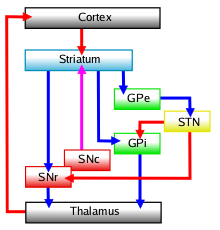Internal globus pallidus
| Internal globus pallidus | |
|---|---|
 Internal globus pallidus (GPi) is seen in the 2nd image from the left | |
| Details | |
| Part of | Globus pallidus |
| Identifiers | |
| Latin | globus pallidus internus, globus pallidus medialis |
| Acronym(s) | GPi |
| NeuroNames | 233 |
| NeuroLex ID | birnlex_1555 |
| TA98 | A14.1.09.511 |
| TA2 | 5572 |
| FMA | 61840 |
| Anatomical terms of neuroanatomy | |
The internal globus pallidus (GPi or medial globus pallidus) is one of the two subcortical nuclei that provides inhibitory output in the basal ganglia, the other being the substantia nigra pars reticulata. Together with the external globus pallidus (GPe), it makes up one of the two segments of the globus pallidus, a structure that can decay with certain neurodegenerative disorders and is a target for medical and neurosurgical therapies. The GPi, along with the substantia nigra pars reticulata, comprise the primary output of the basal ganglia, with its outgoing GABAergic neurons having an inhibitory function in the thalamus, the centromedian complex and the pedunculopontine complex.[1]
Anatomy
[edit]The efferent bundle is constituted first of the ansa and lenticular fasciculus, then crosses the internal capsule within and in parallel to the Edinger's comb system then arrives at the laterosuperior corner of the subthalamic nucleus and constitutes the field H2 of Forel, then H, and suddenly changes its direction to form field H1 that goes to the inferior part of the thalamus. The distribution of axonal islands is widespread in the lateral region of the thalamus. The innervation of the central region is done by collaterals.[2]
The GPi has outgoing GABAergic neurons that connect to the ventral anterior nucleus (VA) and the ventral lateral nucleus (VL) in the dorsal thalamus, to the centromedian complex, and to the pedunculopontine complex.[3]
Function
[edit]
The GPi acts to tonically inhibit the ventral lateral nucleus and ventral anterior nucleus of the thalamus. As these two nuclei are needed for movement planning, this inhibition restricts movement initiation and prevents unwanted movements.
Direct pathway
[edit]The GPi receives inhibitory GABAergic signals from the striatum by way of striatopallidal fibres, when a movement requirement is signaled from the cerebral cortex. As the GPi is one of the direct output centers of the basal ganglia, this causes disinhibition of the thalamus, increasing overall ease of initiating and maintaining movement. As this pathway only contains one synapse (from the striatum to the internal globus pallidus), it is known as the direct pathway.[4]
The direct pathway is modulated by stimulation of the GPi by the external globus pallidus and subthalamic nucleus, via the indirect pathway.[5]
Neurodegenerative disorders
[edit]Dysfunction of the internal globus pallidus has been correlated to Parkinson's disease,[6] Tourette syndrome,[7] and tardive dyskinesia.[8]
The internal globus pallidus is the target of deep brain stimulation (DBS) for these diseases. Deep brain stimulation sends regulated electrical pulses to the target. In patients with tardive dyskinesia treated with DBS, most people reported more than a 50% improvement in symptoms.[8] Tourette syndrome patients have also benefited from this treatment, showing over 50% improvement in tic severity (compulsive disabling motor tics are symptoms of Tourette patients).[7] The GPi is also considered a "highly effective target for neuromodulation" when using deep brain stimulation on Parkinson's disease patients.[6] There is seen to be only some involvement in Huntington's disease[9] with mostly the external globus pallidus being affected.[10]
Animals
[edit]In rodents its homologue is known as the entopeduncular nucleus.[11]
References
[edit]- ^ Schroll, Henning; Hamker, Fred H. (2013-01-01). "Computational models of basal-ganglia pathway functions: focus on functional neuroanatomy". Frontiers in Systems Neuroscience. 7: 122. doi:10.3389/fnsys.2013.00122. PMC 3874581. PMID 24416002.
- ^ Yelnik J, François C, Percheron G, Tandé D (April 1996). "A spatial and quantitative study of the striatopallidal connection in the monkey". NeuroReport. 7 (5): 985–988. doi:10.1097/00001756-199604100-00006. PMID 8804036. S2CID 25425297.
- ^ Percheron G, François C, Talbi B, Meder JF, Fenelon G, Yelnik J (1993). "The primate motor thalamus analysed with reference to subcortical afferent territories". Stereotact Funct Neurosurg. 60 (1–3): 32–41. doi:10.1159/000100588. PMID 8511432.
- ^ Morita, Makiko; Hikida, Takatoshi (2015-11-01). "[Distinct roles of the direct and indirect pathways in the basal ganglia circuit mechanism]". Nihon Shinkei Seishin Yakurigaku Zasshi = Japanese Journal of Psychopharmacology. 35 (5–6): 107–111. ISSN 1340-2544. PMID 26785520.
- ^ Parent, André; Hazrati, Lili-Naz (1995-01-01). "Functional anatomy of the basal ganglia. II. The place of subthalamic nucleus and external pallidium in basal ganglia circuitry". Brain Research Reviews. 20 (1): 128–154. doi:10.1016/0165-0173(94)00008-D. PMID 7711765. S2CID 20808851.
- ^ a b Andrade, Pablo; Carrillo-Ruiz, José D.; Jiménez, Fiacro (2009-07-01). "A systematic review of the efficacy of globus pallidus stimulation in the treatment of Parkinson's disease". Journal of Clinical Neuroscience. 16 (7): 877–881. doi:10.1016/j.jocn.2008.11.006. ISSN 0967-5868. PMID 19398341. S2CID 36080071.
- ^ a b Dong, S.; Zhuang, P.; Zhang, X.-H.; Li, J.-Y.; Li, Y.-J. (2012-01-01). "Unilateral deep brain stimulation of the right globus pallidus internus in patients with Tourette's syndrome: two cases with outcomes after 1 year and a brief review of the literature". The Journal of International Medical Research. 40 (5): 2021–2028. doi:10.1177/030006051204000545. ISSN 1473-2300. PMID 23206487.
- ^ a b Spindler, Meredith A.; Galifianakis, Nicholas B.; Wilkinson, Jayne R.; Duda, John E. (2013-02-01). "Globus pallidus interna deep brain stimulation for tardive dyskinesia: case report and review of the literature". Parkinsonism & Related Disorders. 19 (2): 141–147. doi:10.1016/j.parkreldis.2012.09.016. ISSN 1873-5126. PMID 23099106.
- ^ Waldvogel, Henry J.; Kim, Eric H.; Tippett, Lynette J.; Vonsattel, Jean-Paul G.; Faull, Richard LM (2014-01-01). Nguyen, Hoa Huu Phuc; Cenci, M. Angela (eds.). Behavioral Neurobiology of Huntington's Disease and Parkinson's Disease. Current Topics in Behavioral Neurosciences. Vol. 22. Springer Berlin Heidelberg. pp. 33–80. doi:10.1007/7854_2014_354. ISBN 9783662463437. PMID 25300927.
- ^ Walker, FO (20 January 2007). "Huntington's disease". Lancet. 369 (9557): 218–28. doi:10.1016/S0140-6736(07)60111-1. PMID 17240289. S2CID 46151626.
- ^ Nauta WJ, Mehler WR (January 1966). "Projections of the lentiform nucleus in the monkey". Brain Res. 1 (1): 3–42. doi:10.1016/0006-8993(66)90103-X. PMID 4956247.
